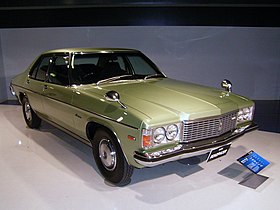Mazda Roadpacer AP
This article needs additional citations for verification. (February 2018) |
| Mazda Roadpacer AP | |
|---|---|
 | |
| Overview | |
| Manufacturer | Mazda |
| Production | 1975–1977 |
| Body and chassis | |
| Class | Full-size car |
| Body style | 4 door sedan |
| Layout | Front-engine, rear-wheel drive |
| Related | Holden HJ Premier |
| Powertrain | |
| Engine | 1.3 L 13B Wankel |
| Dimensions | |
| Wheelbase | 2,830 mm (111 in) |
| Length | 4,850 mm (191 in) |
| Width | 1,885 mm (74 in) |
| Height | 1,465 mm (58 in) |
| Curb weight | 1,575 kg (3,472 lb) |
The Mazda Roadpacer AP (Anti-Pollution) is a full-size sedan that was sold by Mazda in Japan between 1975 and 1977, although the last car was not sold until 1979. It was based on the Australian Holden HJ and HX series Premier.[1] Premiers were shipped to Japan without engines, and Mazda fitted a 1.3-liter 13B Wankel engine into the bay. The engine produced 130 hp (97 kW) but just 102 lb⋅ft (138 N⋅m) of torque, meaning the Roadpacer performed rather poorly as it weighed 1,575 kg (3,472 lb).[citation needed] The Roadpacer was introduced to compete with large Japanese flagship sedans Toyota Century, Nissan President, Isuzu Statesman de Ville, and the Mitsubishi Debonair.
The 13B produced less power than the Red series motors that powered the equivalent Holdens, and significantly less torque, meaning performance was restrained with a 166 km/h (103 mph) top speed, poor acceleration and terrible fuel consumption.[citation needed] Contemporary reports suggest 9 mpg (26 L per 100 km).[2] The vehicle was not in compliance with Japanese regulations concerning engine displacement and exterior dimensions, and was classed in the mid-size car segment, while the engine displacement placed it in the lower annual road tax brackets. If the car was recognized as being for business use as an executive company car, the road tax bill was very minimal.
While the Holden HJ Premier itself was well equipped, Mazda decided to add more. Gadgets of note include a central locking system that activated when the car hit 10 km/h (6.2 mph), a chime system that activated at 90 km/h (56 mph), a dictation system and a stereo able to be controlled from both front and back seats. The Roadpacer was built only for the Japanese market, and certain aspects concerning its lack of speed become evident once its realized that urban two-way streets are usually zoned at 40 km/h (25 mph) or less,[3] as mentioned in the article Speed limits in Japan.

The price was also considered high at 3.8 million yen (US$13,000) in 1975. This was about twice the price of a contemporary Mazda Cosmo or Mazda Luce. Originally intended as transport for high-ranking government officials, the car was sold in the wake of the first fuel crisis and was not a commercial success. Production ceased in 1977 with only 800 units sold.
The Roadpacer AP has the sole distinction of being the only General Motors product being fitted for production with a rotary engine, and the platform used was only the shorter version used by Isuzu for the Statesman de Ville.
Most were sold to government departments and were later crushed, meaning Roadpacers are rare nowadays;[citation needed] their counterpart model, the Holden Premier is considered a classic car in Australia.[citation needed]
References[]
- ^ Bedwell, Steve (2009). Holden vs Ford: the cars, the culture, the competition. Dulwich Hill, New South Wales: Rockpool. ISBN 978-1-921295-17-1.
- ^ https://jalopnik.com/5983180/the-mazda-roadpacer-was-a-big-holden-with-a-rotary-engine-for-some-reason
- ^ "Driving in Japan". Japan-Guide.com. Japan-Guide.com. Retrieved 22 February 2017.
External links[]
![]() Media related to Mazda Roadpacer at Wikimedia Commons
Media related to Mazda Roadpacer at Wikimedia Commons
| show |
|---|
| show |
|---|
- Mazda vehicles
- Sedans
- Cars introduced in 1975
- Cars powered by Wankel engines